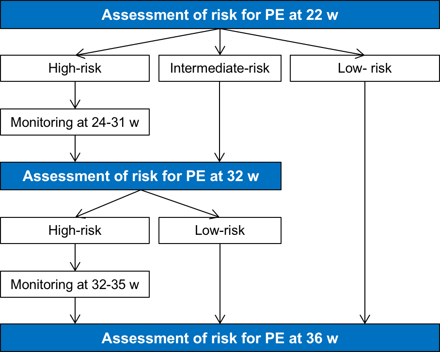Stratification of pregnancy management
20-24 weeks’ gestation
Screening of the whole population by a combination of maternal factors, MAP, UTPI, PLGF and sFLT-1 can be carried out and on the basis of risks for PE the pregnancies are stratified into different management pathways including reassessment of risk and intensive monitoring at various gestational age intervals. The objective would be to maximize the detection of PE at the minimum possible cost in relation to the proportion of the population requiring further assessment and those requiring intensive monitoring.
- High-risk group (risk for PE at <32 weeks of ≥1 in 100). This constitutes about 1% of the total and contains 95% of those that develop PE at <32 weeks. These pregnancies require regular monitoring by measurement of blood pressure and urinalysis at 24-31 weeks. Further intensive monitoring may be necessary for those with ultrasound features of fetal growth restriction at the 22 weeks scan and those that develop hypertension.
- Low-risk group (risk for PE at <36 weeks of <1 in 300). This group, which constitutes >80% of the total, can be reassured that development of PE at <36 weeks is unlikely, but they require reassessment of risk at 36 weeks’ gestation.
- Intermediate-risk group (risk between the high- and low-risk groups above). This group, together with the high-risk group that remains undelivered by 32 weeks’ gestation, constitutes <20% of the total and contains >90% of pregnancies with PE at 32-35 weeks. These pregnancies require reassessment of risk at 32 weeks’ gestation.

